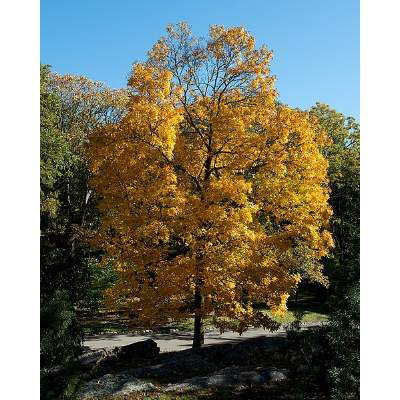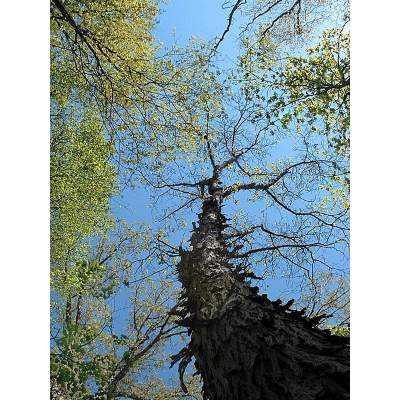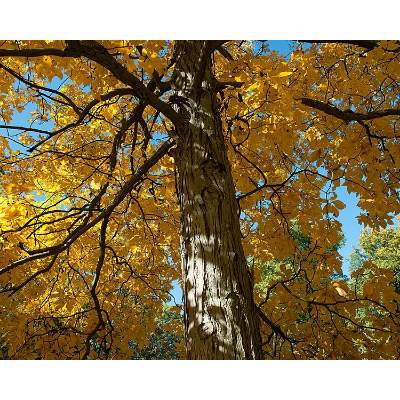The Shagbark Hickory tree offers ornamental beauty, early spring blooms, and attracts wildlife. It is drought-tolerant, low-maintenance, and provides erosion control and shade. Its compact size makes it suitable for various landscapes, and it is pollinator-friendly with edible flowers. However, it has a relatively short lifespan and can be messy due to its seed pods. Its invasive roots and pruning challenges are also noteworthy drawbacks.
| Pros | Cons |
|---|---|
| Ornamental Beauty | Short Lifespan |
| Early Spring Blooms | Messy Seed Pods |
| Wildlife Attraction | Invasive Roots |
| Drought Tolerance | Pruning Challenges |
| Low Maintenance | |
| Erosion Control | |
| Shade Provider | |
| Compact Size | |
| Pollinator Friendly | |
| Edible Flowers |
Pro: Ornamental Beauty
The Shagbark Hickory tree, known scientifically as Carya ovata, stands as a testament to nature’s artistic prowess. With its distinctive shaggy bark that peels away in long, graceful strips, this tree exudes a rustic and timeless charm that can enhance the aesthetics of any landscape. The rugged, textured bark provides a visually appealing contrast to its surroundings, making it an eye-catching addition to gardens and yards.
The Shagbark Hickory’s unique bark serves more than just an ornamental purpose. It also provides an interesting tactile experience, inviting you to touch its rough, peeling surface. This tactile aspect further enhances its overall aesthetic appeal, making it a conversation piece for those who encounter it in your garden.
Also Read :
Eastern Redbud Tree Pros and Cons – 20 Facts You Need to Know
As an Amazon Associate we earn from qualifying purchases.
Table of Contents
Celebration Maple Tree Pros And Cons – 8 Facts You Need to Know
Brandywine Maple Tree Pros And Cons – 7 Facts You Need to Know
Chitalpa Tree Pros and Cons – 9 Facts You Need to Know
Purple Robe Locust Tree Pros and Cons – 10 Important Facts
River Birch Tree Pros and Cons – 16 Facts You Need to Know
Hickory Tree Pros and Cons: 7 Facts You Need to Know
Hazelnut Tree Pros and Cons – 10 Facts You Need to Know
October Glory Maple Tree Pros And Cons – 9 Amazing Facts
Pro: Early Spring Blooms
Early spring is a season of rebirth and renewal, and the Shagbark Hickory tree plays a part in this natural symphony. In early spring, this tree bursts into bloom, adorning its branches with clusters of delicate, yellow-green catkins. These catkins sway in the breeze and attract not only the eye but also a variety of pollinators, including bees and butterflies.
The early spring blooms are not just a visual delight but also a source of life for the pollinators that visit your garden. They provide nectar and pollen, contributing to the overall health of your garden ecosystem. Additionally, the bright green catkins against the backdrop of awakening nature create a soothing and tranquil ambiance.

Pro: Wildlife Attraction
One of the remarkable pros of the Shagbark Hickory tree is its ability to serve as a wildlife magnet. This tree’s branches and leaves offer shelter and nesting sites for birds, and its nuts, once mature, become a valuable food source for various animals, including squirrels and chipmunks. This makes it an excellent choice for those looking to encourage wildlife in their garden or backyard.
The presence of wildlife can bring a sense of vitality to your outdoor space, and the sounds of birdsong and the sight of playful squirrels can be a source of constant delight. It also contributes to the overall balance of the local ecosystem, promoting biodiversity.
Pro: Drought Tolerance
In a world where water conservation is becoming increasingly important, the Shagbark Hickory tree’s drought tolerance is a valuable asset. It can thrive in conditions with limited water availability, making it suitable for regions that experience dry spells or where water conservation is a priority.
The ability of this tree to withstand drought means you can enjoy its many benefits without excessive water use. It serves as a testament to nature’s ability to adapt to different environments and continue to thrive.
Pro: Low Maintenance
Low-maintenance landscaping is a goal for many homeowners, and the Shagbark Hickory tree makes this goal attainable. Once established, this tree requires minimal care and attention. It is relatively resistant to pests and diseases, reducing the need for chemical treatments or frequent monitoring.
The low maintenance nature of the Shagbark Hickory tree means you can spend more time enjoying your garden and less time tending to it. It also makes it an excellent choice for those who are new to gardening or have busy schedules.
Pro: Erosion Control

Erosion can be a significant issue in some landscapes, especially in areas with sloping terrain or near bodies of water. The Shagbark Hickory tree can be a powerful ally in combating erosion due to its extensive root system. The roots help stabilize the soil and prevent it from being washed away during heavy rains.
In regions prone to erosion, planting Shagbark Hickory trees strategically can help protect your property and the surrounding environment from the negative effects of soil erosion. The roots also create a natural, rustic appearance that enhances the landscape’s overall appeal.
Pro: Shade Provider
The Shagbark Hickory tree’s canopy offers a generous shade that can be a blessing during the hot summer months. Whether you’re looking to create a cool and comfortable outdoor living space or protect delicate plants from scorching sun, this tree’s broad leaves provide a natural solution.
The dappled shade created by the Shagbark Hickory tree is ideal for setting up seating areas, picnics, or a cozy hammock. It allows you to enjoy your outdoor space without being exposed to the full force of the sun, promoting relaxation and comfort.
Pro: Compact Size
While the Shagbark Hickory tree has the potential to grow quite tall and broad, it generally maintains a manageable and compact size compared to some other tree species. This makes it versatile and suitable for a range of landscapes, from small urban gardens to larger rural properties.
Its compact size is especially appealing for those who want to enjoy the tree’s many benefits without worrying about it overshadowing other elements of their garden or creating maintenance challenges. You can easily integrate it into your landscape design without sacrificing space or compromising on aesthetics.
Pro: Pollinator Friendly
In an age where pollinator decline is a growing concern, the Shagbark Hickory tree stands as an ally to bees, butterflies, and other pollinating insects. Its early spring catkins and edible flowers provide a valuable source of nectar and pollen.
Creating a pollinator-friendly garden not only supports these vital creatures but also enhances the overall health of your garden. Increased pollination can lead to better fruit and vegetable yields, making it a win-win situation for both nature and garden enthusiasts.
Pro: Edible Flowers
While many trees are admired solely for their appearance, the Shagbark Hickory tree adds a practical twist to its aesthetic charm. Its flowers are not just visually pleasing but also edible. The flowers have a mild, nutty flavor, making them a unique addition to your culinary repertoire.
Adding Shagbark Hickory flowers to your dishes, salads, or garnishes can be a delightful culinary experiment. It’s a chance to connect with nature and experience the flavors it has to offer in your own backyard.
Con: Short Lifespan

As with many things of beauty, the Shagbark Hickory tree’s life is relatively short-lived in the grand scheme of nature. While it can provide decades of enjoyment, it typically has a lifespan of 100-200 years. This means that after a century or two, you may need to bid farewell to a tree that has become a cherished part of your landscape.
The tree’s relatively short lifespan is a consideration for those looking for a long-term investment in their garden. However, the beauty and benefits it provides during its lifetime often make up for this drawback.
Con: Messy Seed Pods
One of the less glamorous aspects of the Shagbark Hickory tree is its seed pods, which can create a bit of a mess in your garden. The tree’s nuts are encased in hard, woody husks that, when they fall to the ground, can litter your yard and create a somewhat untidy appearance.
The messiness of the seed pods can be a source of annoyance for some garden enthusiasts, especially those who prioritize a neat and well-maintained outdoor space. Regular cleanup may be required to keep your garden looking its best, particularly during the fall when the tree sheds its nuts.
Despite the inconvenience of the seed pods, some gardeners find creative uses for the nuts, such as crafting or feeding wildlife. While they may be messy, they also offer an opportunity for resourcefulness and a connection with nature.
Con: Invasive Roots

The Shagbark Hickory tree’s root system, while beneficial for preventing erosion, can pose challenges in certain situations. The roots of this tree have a reputation for being strong and occasionally invasive. They can extend far from the tree’s base and potentially interfere with nearby structures like sidewalks, driveways, or septic systems.
Gardeners in urban environments or those with limited space may find the tree’s invasive roots a disadvantage. Careful planning and maintenance are necessary to mitigate potential issues related to the tree’s root growth.
Con: Pruning Challenges
Maintaining the Shagbark Hickory tree’s distinctive shaggy bark and elegant form can be a demanding task when it comes to pruning. The tree’s irregular bark pattern can make it tricky to prune and shape in the desired manner, requiring the gardener’s patience and expertise.
Furthermore, over-pruning or improper pruning can harm the tree and hinder its natural beauty. It’s essential to consult with a professional arborist or someone experienced with Shagbark Hickory trees to ensure that pruning is carried out correctly.
In summary, the Shagbark Hickory tree is a remarkable addition to any garden or landscape, offering ornamental beauty, early spring blooms, wildlife attraction, drought tolerance, and low maintenance. It excels at erosion control, provides shade, has a compact size, is pollinator-friendly, and even boasts edible flowers. However, it does come with its share of drawbacks, including a relatively short lifespan, messy seed pods, invasive roots, and pruning challenges. Choosing this tree for your garden is a decision that should consider both its pros and cons, ensuring it aligns with your gardening goals and preferences.
© 2024 Lotusmagus.com. All rights reserved. This content is protected by copyright. Visit Lotusmagus.com for more information.
